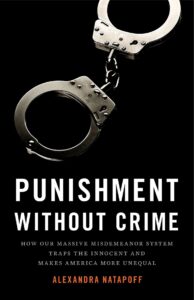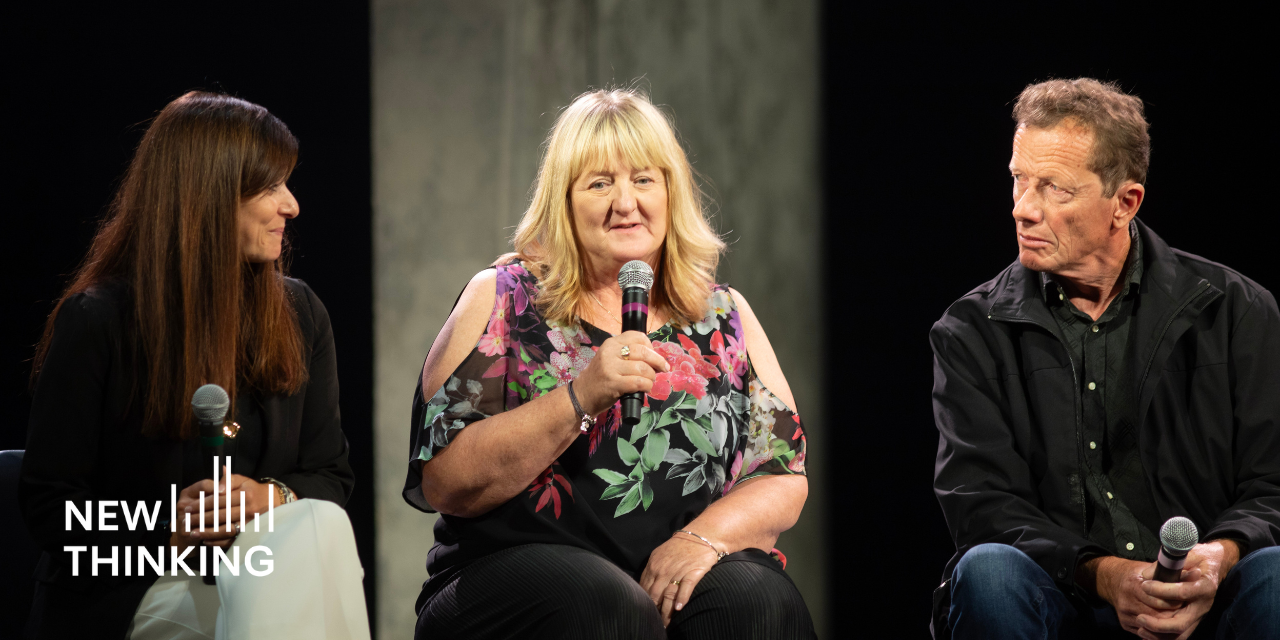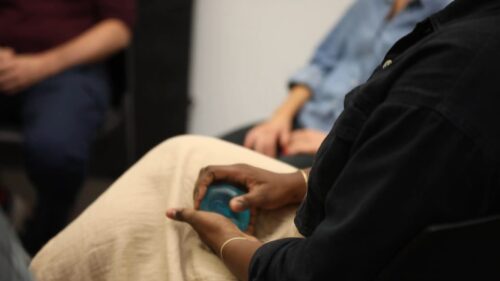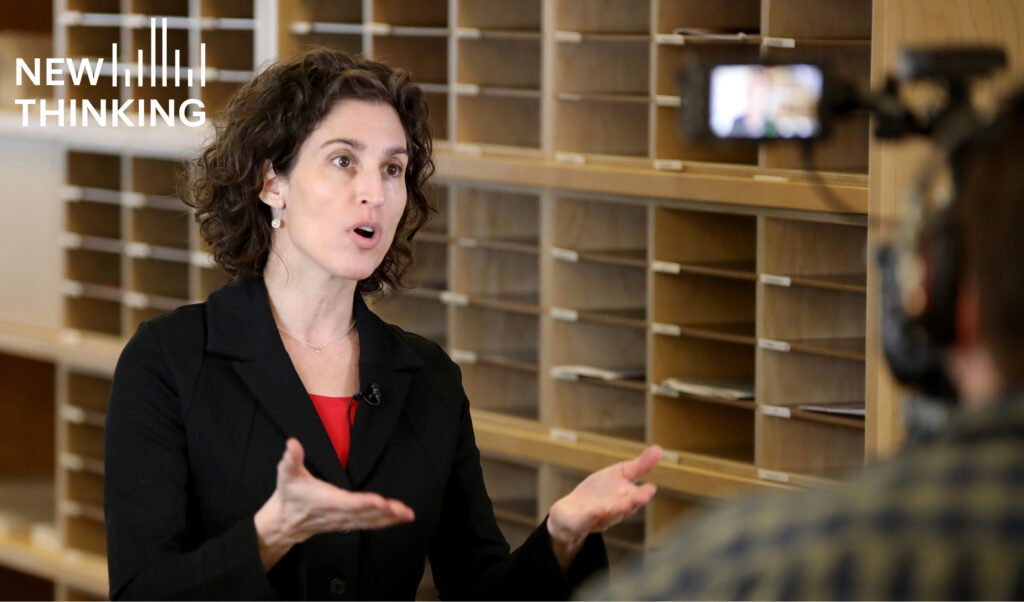
We criminalize low-level, often harmless, conduct, sweeping in millions of people in ways that have flown beneath the radar.
Misdemeanors are the poor stepchild of the criminal justice system. There are no police procedural TV shows focused on them, no innocence projects for the wrongfully convicted, and not even much attention from legal scholars and criminal justice reformers.
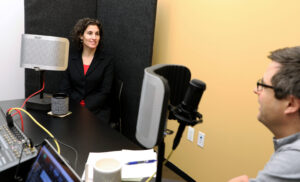
Natapoff and New Thinking host Matt Watkins
Yet misdemeanors are the primary way that most Americans experience the justice system. With an estimated 13 million filings per year, misdemeanors make up four of every five criminal cases in the U.S. As Malcolm Feeley wrote four decades ago in The Process Is the Punishment, his classic study of a lower criminal court: “Whatever majesty there is in the law may depend heavily on these encounters.”
Far from majestic, however, Alexandra Natapoff says the misdemeanor system—a sprawling, poorly-understood archipelago of local institutions and laws—is failing, in troubling and consequential ways. Natapoff is a professor of law at the University of California, Irvine, and the author of Punishment Without Crime: How Our Massive Misdemeanor System Traps the Innocent and Makes America More Unequal (Basic Books).
Natapoff notes the consequences of a misdemeanor conviction can trail someone for life: affecting their immigration status, and their ability to get a job, housing, or a bank loan. Yet many people charged with a “petty offense” are quick to plead guilty in return for what they think will be a hasty exit from the system. Indeed, Natapoff says, the system is predicated on securing such pleas, even from the innocent.
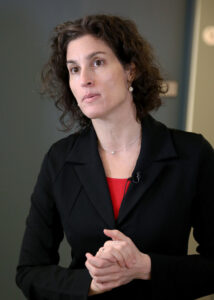
Through its reliance on fines and fees, and the manner in which “order-maintenance” enforcement has historically targeted the poor and communities of color, Natapoff sees a misdemeanor system that is “as influential an engine of social and racial inequality as low-quality public schools, the unavailability of public housing, or our thinning social safety net.”
However, she says the means of fixing the system—starting with greatly reducing the number of people caught up in it in the first place—are obvious, and already taking place in pockets across the country.
Resources and References
- ‘How a Simple Misdemeanor Could Land You in Jail for Months‘—Natapoff’s op-ed in The New York Post (01.19)
- ‘The New Debtors’ Prison‘—A New York Times Magazine feature on the impact of justice-system fines and fees (01.19)
- ‘When the Police Become Prosecutors‘—Natapoff’s op-ed in The New York Times on one of the more troubling variations of the local misdemeanor system (12.18)
- ‘Boston’s New D.A. Pushes Back Against Prosecutors’ “Punishment-Centric” Point of View‘—New Thinking guest John Pfaff writes in The Appeal on Rachael Rollins’s decision to decline to prosecute certain low-level offenses (11.18)
- ‘Misdemeanorland: Social Control and New York City’s Lower-Level Courts‘—Sociologist Issa Kohler-Hausmann on New Thinking (10.18)
- ‘Understanding Risk and Needs in Misdemeanor Populations‘—An in-depth profile of New York City misdemeanor defendants from the Center for Court Innovation (06.18)
- ‘Toward Misdemeanor Justice: Lessons from New York City‘—The Center’s Greg Berman and Julian Adler in the Boston University Law Review (06.18)
- ‘The Scale of Misdemeanor Justice‘—An attempt at “the most comprehensive national-level empirical analysis of misdemeanor criminal justice that is currently feasible,” in the Boston University Law Review (06.18)
- ‘The 12 Key Highlights from the DOJ’s Scathing Ferguson Report‘—A summary from The Washington Post (03.15)
The following is a transcript of the podcast:
Matt Watkins: Welcome to New Thinking from the Center for Court Innovation, I’m Matt Watkins. Misdemeanors seem like the poor stepchild of the criminal justice system. There are no police procedural TV shows focused on them, there’s no innocence projects for the wrongfully convicted, and there’s not even much attention from legal scholars and criminal justice reformers.
Yet misdemeanors make up 80 percent of criminal cases across the country and they are the primary way that most Americans experience the justice system. And our guest today says that system is failing, badly—in some truly troubling and consequential ways. Alexandra Natapoff is a Professor of Law at the University of California, Irvine, and the author of Punishment Without Crime: How Our Massive Misdemeanor System Traps the Innocent and Makes America More Unequal, and it’s published by Basic Books. Alexandra, thanks so much for joining us today.
Alexandra Natapoff: Thank you so much for having me.
Watkins: So you talk a fair bit, or I guess lament a fair bit, in your book about the felony-centric view that the reform community tends to take and the scholarly community tends to take, and so focusing on the more serious crimes. But you have chosen to focus on what I’ve called this poor stepchild of the criminal justice system: misdemeanors. Is it something in your biography or what led you to this particular focus?
Natapoff: I’ve always been surprised at how little attention we pay to misdemeanors to the low-level criminal system precisely because it makes up so much of what our criminal process does, and as I got deeper into the question—as I researched issues around misdemeanor processing, as I started to gather data about misdemeanor systems across the country—I became persuaded that we can’t really understand American criminal justice without profoundly engaging in how we run the petty offense process. It fuels much of the racial skew of our criminal system, the wealth-based and class-based skew against the poor of our criminal system, all of which we have come to understand as part of the harshness and wrongfulness of mass incarceration. But it starts at the bottom, it starts with misdemeanors at the bottom of that criminal justice pyramid with these low-level petty cases that we just haven’t really paid enough attention to.
Watkins: So let’s start maybe with defining some terms, these low-level petty offenses, what exactly are they? I mean obviously misdemeanors, it’s a very broad and flexible term and that’s part I think of the focus of your book and why you talk about people being trapped by this sort of capacious system, but what are the most representative misdemeanors out there?
Natapoff: So you’re right, misdemeanors is an enormously broad term. It covers all kinds of offenses, from the most minor loitering and jaywalking, all the way up to relatively serious offenses like domestic violence or DUI. Every jurisdiction defines it a little bit differently, all over the country a misdemeanor, the standard definition is a crime for which you can serve no more than one year in jail. There are conversely what we call non-jailable misdemeanors, still a criminal offense, but you can’t go to jail for it, at least not up front, not right away. So, it is an enormous category.
The way I think about it is not so much as a techie-term defining any particular one crime, but as an aspect of our criminal system that we criminalize low-level, often harmless or minor conduct on the scale of millions of cases and millions of people in low-level courts in ways that we do not scrutinize or lavish resources on, we sweep in millions of people in ways that have flown beneath the radar. And so the term misdemeanor kind of captures all the conduct and offenses and processes through which we operate this low-level process in ways that frankly really contradict many of our principles of criminal justice.
Watkins: And that term is so broad, or its use is so broad. I was struck by this category of loitering, which is a misdemeanor, meaning what exactly? Meaning milling around with no clear purpose? What are the consequences of that kind of thinking, that kind of lens that the criminal justice system is viewing behavior by?
Natapoff: So the misdemeanor process is a way that we turn normal everyday behavior—maybe disruptive behavior or unpleasant behavior or behavior that we wish people wouldn’t engage in—into a crime. And we’ve grappled with that legally, so there are Supreme Court cases that have imposed limits on the extent to which the state can make very vague conduct a crime. So, vagrancy is the famous one—for hundreds of years, people were convicted of the misdemeanor of vagrancy, which really just meant not having a job or not being able to account for yourself.
Loitering is sort of the kissing cousin of vagrancy. Very vague loitering statutes have been held unconstitutional, but most cities have some form of loitering statute: standing around for an illegal purpose, standing around in ways that impede vehicular or pedestrian traffic. These are minor kinds of conduct that we turn into crimes, not because we’re afraid of the conduct, but because we want to give police the tools to interfere with the people who are engaged in this kind of conduct. So we can understand them as a form of social control, a conferring of power on the state to say, “look, we’re not worried that you’re standing in the way of traffic. We’re worried about the class of people who might do those kinds of things and we’re going to empower police to interfere with their liberty.”
Watkins: And then you refer to the misdemeanor system as a sprawling system and properly speaking, it shouldn’t even get a singular noun; there is no one singular system out there, it’s a very hard thing to actually talk about. So could you explain the nature of this sprawling aspect, this sort of archipelago of misdemeanor institutions, and then I just imagine that must’ve been something difficult for you to analyze and to write about.
Natapoff: In the title of the book, in the subtitle of the book, I say the misdemeanor system, and that’s a metaphor. There is no one misdemeanor system in this country, there are thousands of pieces of the misdemeanor phenomenon. Thousands of prosecutor offices, police departments, low-level courts, public defender offices, jails, sheriff departments, all of these come together to form the pick your metaphor, system, leviathan, behemoth…
Watkins: “Quiet behemoth,” I think you call it, at one point.
Natapoff: It’s getting louder! And part of the reason it’s hard to pick a good word is because it is such an enormous system, it’s hard to pin down, it varies wildly from place to place, from state to state. But I think it’s important to conceptualize it as a whole in the same way that we conceptualize, for example, the American education system as a whole, not because it’s consistent or even one system, it’s as diverse and sprawling as our criminal system. But education as an institution, as a public policy, we understand that writ broad, it profoundly affects our democracy, and misdemeanors are like that. The way we permit our states, our counties, our cities to create and prosecute and process misdemeanors is every bit as important as the way we handle issues like education or public housing or public health.
Watkins: Yes, I mean along with your book, having a pretty powerful narrative that’s carrying it forward and taking apart the process and showing the continuities back to the Middle Ages, for example, as you were saying, with vagrancy laws, it’s also a very numbers-driven book and it really seems like you had to do this Herculean amount of labor to assemble the data on what’s actually going on out there. Could you talk a little bit about what the challenges are of finding out what is actually going on and is that difficulty by design or just simply the fact that the system has grown up in this pell-mell fashion?
Natapoff: It was very difficult to get a strong empirical picture of the misdemeanor system nationally in part because it is so sprawling and it is so diverse and it’s comprised of so many small individualized institutions. There’s no central authority that counts misdemeanors in this country, there’s no central authority to regulate it, our criminal system is a profoundly local phenomenon. I took my best shot at it. I sent a records request to every state office, they’re called the administrative office of the court, every state has one. Its job is to basically keep track of what its criminal system is doing, and I asked every office: how many misdemeanors do you file every year in your state? I actually asked them for one year, for 2015. How many misdemeanors did you file in 2015?
Watkins: And no one had done that before?
Natapoff: As far as I know, no one had reached out to every state in this way to ask. Every state produces an annual report, so I gathered information from every report and then I looked for everything I could find, every ACLU report, every public defender annual report, every place I thought I might get a better sense of how many cases there are and what kind of cases are making up these dockets. With that, on the basis of that enormous pile of information that I collected, I concluded that approximately 13 million misdemeanor cases were filed in 2015 in the United States.
But to be absolutely clear, the picture that I obtained was partial. I couldn’t get information from every state or the kinds of information that I wanted, but not for want of trying, as you point out, a lot of that data is just not out there yet.
Watkins: You say that an important myth that the system is constructed on, and I guess the way it achieves what public legitimacy it has, is this idea that the crimes are minor and then the sanctions are minor too. This is the story that we tell ourselves about the system, so it’s not worth getting that exercised about, but in fact, it’s at the heart of the book that you show that the consequences of a misdemeanor conviction and even just the process itself, even if you’re not actually found guilty in the end, that those consequences can actually derail a person’s life, that the consequences are anything but petty, and that I think is a real contribution from your book that people haven’t really appreciated hitherto. So do you want to talk a little bit about what are some of these really shattering consequences that people experience?
Natapoff: I think it’s one of the great myths of the misdemeanor system that encountering the process or getting a misdemeanor conviction is not that big a deal. It’s a myth that validates a lot of the sloppiness of the system. It’s one of the reasons we accord less due process in misdemeanor courts, it’s one of the reasons we don’t give every misdemeanor to a lawyer, it’s one of the reasons that we expend fewer resources because we perpetuate this myth in effect that it’s not such a big deal to be punished and therefore we’re going to make it easier to sweep you into the system and convict you in the first place. And it’s just wrong. The impact of a misdemeanor conviction extend all the way from, and I think we’re paying more attention, to the burden and the stigma of a criminal record, those criminal records are permanent. They dog people for their entire lives, employers tell us that they routinely check people’s criminal backgrounds even for misdemeanors when deciding whether to make them a job offer, landlords look at criminal records including misdemeanors.
A misdemeanor conviction can affect your credit, it can affect your eligibility for professional licenses, it can affect your ability to get a loan or financial aid, of course it can affect and does affect your immigration status, some misdemeanors are deportable offenses. So there’s a vast array of personal, long-term economic and social consequences they’d go even with a very minor conviction that I don’t think has been fully appreciated.
I think one of the reasons frankly, is that we’ve been grappling with mass incarceration for so long: those extraordinarily harsh, multi-decade sentences, solitary confinement, the death penalty. Our felony system is so harsh that it does make misdemeanor punishments seem minor in comparison. And I want to suggest it’s the wrong comparison. We shouldn’t be comparing misdemeanor punishments to 30-year federal drug sentences. We should be appreciating the real lived burdens and experiences that actual people and families encounter when they or someone that they love gets a misdemeanor conviction and that is the appropriate metric. From that perspective, they’re really quite punitive.
Watkins: So when you talk about the way that people are swept into the system, a central contention of your book is that the system has evolved in such a way as to pretty efficiently, if that’s the word, narrow people, wring people into situations where they are pleading guilty, where they are forced to plead guilty often to a crime that we don’t think that they actually committed.
Natapoff: In the American criminal system, 95 percent of all convictions—all, felony and misdemeanor—are the result of a plea, not of a trial. We almost never go to trial in this country anymore. Those pleas are the result of a complicated process, which can be very different at the felony level than it is at the misdemeanor level.
So, a serious felony plea, for example, in federal court or to a very serious crime, could be the result of months of investigation and litigation and negotiation. That plea might take place in the shadow of a rigorous evaluation of the evidence and of the applicable law. That almost never happens in the misdemeanor context. So the fact that we have high plea rates in misdemeanors means something different or at least can mean something very different than the fact that we have high plea rates for very serious felonies.
We know, for example, and this is why bail is so important for misdemeanors, we know that people facing bail amounts that they can’t pay often plead guilty to low-level offenses just in order to go home. And if we think about that calculus for a moment, the idea that it would be rational for an individual to say, “I’ll take the misdemeanor conviction, because it’s more important that I not lose my job.” People don’t take a murder conviction in order to get out of jail just to go home. Because the offenses are petty, because people perceive them to be petty, the incentives look different, and so people are more willing to take deals that they wouldn’t necessarily take if they understood the offenses to be more serious as they do when we label those offenses a felony.
Watkins: And if they understood how serious the consequences are of pleading guilty to even a petty offense.
Natapoff: I think that if people better understood the full consequences of pleading to a petty offense then the calculus would look very different. They might resist pleading guilty even if they couldn’t make bail, they might resist pleading guilty even if the process takes very long. So ironically, the misdemeanor system is both very, very fast and very, very slow. It’s very, very fast if you’re willing to plead guilty and often very, very slow if you want rigorous representation, if you want to go to trial, if you want to file motions.
Watkins: The system punishes you for wanting a more rigorous examination. You’re not given the reward of a speedy exit from the system.
Natapoff: The system makes it very expensive and difficult to exercise your rights to examine the evidence, to litigate, for example, whether the police behaved legally in your case. And so all the incentives point towards pleading guilty as quickly as possible. And it’s a rare defendant who has the resources and the time and the money, or the information, or in our overwhelmed public defense system, the legal representation resources to resist that significant pressure.
Watkins: So then how serious, it must be a hard thing to get a handle on, but how serious do you think the innocence problem is in the misdemeanor justice system of people pleading to things they didn’t actually do?
Natapoff: I think the innocence problem is enormous and underappreciated. I devote a chapter in the book to it because I think that we just haven’t grappled with what is probably the scale of wrongful convictions in the misdemeanor system, and wrongful convictions that land on the most vulnerable: people of color in highly-policed neighborhoods who are likely to be wrongfully arrested for crimes like loitering, trespassing, disorderly conduct, which they very well may not have committed who end up in jail and can’t make bail or end up being pressured by the system to take a plea and take it.
Those are wrongful convictions. Those are wrongful convictions, because of the scale of the misdemeanor system that probably happen thousands, if not hundreds of thousands, of times every year, a vast wrongful conviction docket that we pay almost no attention to in the same way that we have accorded insufficient attention to the misdemeanor phenomenon as a whole. I think it’s an exciting moment in this conversation, I know that folks in the innocence movement, in the innocence project are starting to take a look at misdemeanors, at the pressure to plead guilty at the sources of these wrongful convictions, like lack of counsel.
Watkins: We’ve already talked about race and the misdemeanor justice system, because you can’t have a conversation about the criminal justice system for very long if you’re being honest and not talk about race, but can we delve into a bit more how you see the misdemeanor justice system as being a leading engine of racial inequality in this country? How at every step of the process—police, prosecutors, judges—you have this system that is unfairly targeting, and then unfairly convicting, people of color, particularly African Americans, and particularly African-American men.
Natapoff: The misdemeanor system I think is one of the great, under-appreciated engines of racial inequality in this country. It is the first moment where our massive criminal system reaches out and identifies and touches and marks people of color for low-level conduct, for often harmless conduct—marks them as criminal, arrests them, brings them into the system, gives them that first criminal conviction, gives them that first experience of jail, gives them that first understanding that they will disproportionately be targeted by the police. We have come to understand mass incarceration as an engine of racial disparity and racial discrimination, and I think we need to understand that it starts even earlier than that before anyone ever goes to prison. That it is the misdemeanor net that is the first step of racializing crime in this country and it’s taking place under the radar in these highly discretionary, low-level, chump-change arrests and cases that we are paying insufficient attention to.
Once we pay attention to the misdemeanor system as an engine of racial disparity—as an engine of, in many ways, racial social control because we use the misdemeanor system to over-police communities of color, poor communities of color—then we can see that the misdemeanor system is not just a criminal system, it’s as influential an engine of social inequality and racial inequality as low-quality public schools, as the unavailability of public housing, as our thinning social safety net, as residential segregation.
It is one of the ways that state policy affirmatively disadvantages people of color. It has not been held to account as a system, as a public policy, it has not been forced to account for those decisions in the enormously influential systemic way that it does, and I think if nothing else, that is the first thing we need to recognize about it.
Watkins: And it’s a story of racial control and American history. I mean, we’ve seen the argument about the continuity of the criminal justice system being used in these racist ways more when we talk about mass incarceration, and you really take it into the misdemeanor justice world and show how this low-level but constant form of control goes back to at least the backlash against Reconstruction after the Civil War and the 13th Amendment and a way of enslaving people by other means—at which point it becomes a deeply troubling story. All of this coming out of the misdemeanor system.
Natapoff: It really is an incredible history, again, that we just haven’t appreciated. So take the misdemeanor saga all the way back to the end of the Civil War and Emancipation, the southern states essentially converted their misdemeanor courts, their misdemeanor processes, into a mechanism for re-enslaving African-American labor. Local sheriffs and local magistrates essentially colluded to reach out and round up African Americans, arresting them for low-level offenses—it’s going to sound very familiar—for loitering and trespassing or vagrancy and clearing the corners and gambling and spitting and vagrancy and charging them with these crimes, imposing unpayable fines and fees, which of course these indigent defendants couldn’t pay, and then selling them, using that punitive criminal sentence, in effect, to sell those individuals to local industry: to farms, to factories, to mines…
The industry stepped up as the surety, they essentially paid the bond on those individuals, and converted them back into slave labor. Thousands of people died, it was a collusion that lasted all the way up until World War I, until the federal government took seriously the fact that they really hadn’t ended slavery in the southern states through this kind of forced labor.
Watkins: So you’ve started alluding to this in your answer as you were talking a little bit about the way the influence of money creeps into the system. One thing you do, I think, really well in your book is you follow the money, that famous injunction. And when you follow the money, and the way that money incentives are coursing through the misdemeanor justice system, when you pull together all of the aspects of that, it becomes a very disturbing portrait. So could you talk a little bit about what role money is playing in the system, maybe first as an incentive for jurisdictions and what that’s doing to the ideal of justice?
Natapoff: It would be hard to exaggerate the role of money in the misdemeanor system at every stage, for every player, every set of incentives. After the Department of Justice issued its Ferguson Report, I think the nation was essentially put on notice that there are thousands of cities, thousands of jurisdictions all over the country that are feeding off the revenue stream generated by misdemeanor fines and fees. We are only just starting to grapple with that economic reality.
Those incentives affect courts, they affect prosecutor offices, they affect public defender offices, probation offices, sheriffs—there’s almost no institution that is unaffected by that potential incentive to use those cases, and the fines and fees that flow from those cases, to fund those cash-strapped institutions. It varies from place to place, so some jurisdictions rely more heavily on those fines and fees than others; it is not universal, and it is not smooth.
It is profoundly regressive because our criminal system disproportionately goes after the poor, the low-income, and the disadvantaged, so it is a profoundly vicious cycle. We are starting to understand it better, we are starting to see pushback, but I think it will take a great investment into rethinking how our lower court system should work to wean those institutions off those revenue sources. Otherwise, if you leave those institutions to their own devices, they’re always going to be under pressure to raise money from their own subjects who will always be disadvantaged, who will always be low-income. So we’re just inviting that debacle.
Watkins: And there’s been a lot of attention to private prisons, which is a small but troubling phenomenon, but there’s also a lot of private business interests that are swimming around misdemeanor justice system and also effectively making a fair bit of money off the system.
Natapoff: Privatization in the misdemeanor system, we haven’t even fully charted the extent to which it has permeated these low-level courts and these low-level processes, in part because we know so little. But private probation, bail bondsmen, electronic monitoring, debt collectors… So the payment programs for folks who cannot pay their fines and fees, they’re put on a payment plan. If they don’t pay those fines and fees, many courts turn that debt over to private debt collectors, who not only collect that debt but can impose up to 40 percent surcharges on essentially late fees.
So there are all these private players and private industries feeding off that revenue stream in profoundly regressive and dysfunctional ways that we haven’t even fully charted. So I think part of the transparency mandate is, as you say, following the money, we have to start rethinking who should be permitted to make money off the backs of poor people swept into our misdemeanor system.
Watkins: Just to turn to look at those poor people swept into the system, I don’t think people fully appreciate just how inverted the process is. I mean, in terms of the people receiving fines and fees and then being unable to pay a fine and receiving a fee because they’re unable to pay the fine and then maybe ending up in jail because of that.
Natapoff: So bottom line, we impose unpayable fines and fees on poor people who are convicted of low-level crimes, sometimes crimes for which they could not go to jail—non-jailable offenses—even traffic offenses. When they don’t pay those fines and fees we lock them up.
Watkins: And sometimes charge them for the privilege of being locked up as well.
Natapoff: And then we charge them for flunking their probation, we charge them for the warrant that we issued to take them to jail, we charge them daily jail fees. Those fines and fees keep accumulating, they don’t go away. People can be burdened for years with this criminal justice debt, all stemming from absurdly minor offenses that under no scenario warrant this kind of punitive long-term treatment.
Watkins: So this is why you and others use this language of a debtor’s prison—which is supposed to be outlawed, you’re not supposed to be able to imprison people because they can’t pay their debts.
Natapoff: It’s part of the American revolutionary fabric, actually, every state has a law or constitutional provision that outlaws civil debtor’s prison. The idea is if you’re poor, your creditors should not be able to manipulate the criminal justice apparatus to lock you up just to extract their money. If you don’t pay your credit card debt, the bank can’t lock you up. And yet in the misdemeanor system, and it’s one of the reasons we call it, the phenomenon, the New Debtors’ Prison, that is essentially what’s happening. People are getting locked up, not because of the crime they committed, but because they’re too poor to pay a fine or fee.
Watkins: So we’re a forward-looking place here, but before I end the interview by asking you what are some of the prescriptions, what are some of the reforms we can make, what’s already going on out there, I do want to ask you: is the system by its own terms that you’re describing, is it broken or is it working pretty much as it’s intended to work?
Natapoff: We need a criminal justice system; we need a low-level criminal justice system. Nobody wants to live in a community in which people are breaking into their cars or they feel like their bodies or property are not safe from low-level incursions. I think that the state owes that to its subjects. The question is, how do we do that in a way that is just, equitable, racially equitable, fair, and lawful?
I’m a criminal law professor. I teach criminal law, and one of the things every first-year law student is taught is: what are the classic purposes of punishment? And we go all the way back to Hobbes and Kant and the great philosophers, and the classic purposes of punishment are: retribution, sometimes people do terrible things and the criminal system, and our society, needs to respond to it; rehabilitation, giving people a second chance; deterrence, teaching everybody “don’t do it.” And when all else fails, we incapacitate dangerous people, if we just can’t figure out how to integrate them back into society. The misdemeanor system has substituted revenue generation, professional perpetuation, bureaucracy for those profoundly important social purposes. We need to get off that boat!
Watkins: And there’s a very practical task of shrinking the system, of bringing fewer people into it. Are there reforms out there already that you think are doing that work of shrinking the system, of decreasing the footprint of the system?
Natapoff: I think that shrinking the system is the way to understand reform, and there are many straightforward, practical ways of doing that, some of which are already happening in many jurisdictions. So, decriminalization and legalization are a way of shrinking the misdemeanor system. Of course, marijuana is our great ongoing experiment in taking crimes off the book, but decriminalizing traffic offenses, decriminalizing low-level order offenses, so that those kinds of offenses are no longer routing people into a criminal system, but into a civil or administrative system, or a system of citations or tickets, if it’s absolutely necessary.
So legislatures have a role to play in shrinking the net, police have a role in ratcheting back on the number and the kinds of arrests that they make so that that pipeline is not filled up in the first place disproportionately with poor people, with people of color, for these low-level offenses. Prosecutors can immediately make an impact on shrinking the pipeline through stronger screening and declination processes. And then we can shrink the system by punishing people less, by putting fewer people in jail, by letting go of the terrible debtors’ prison model. This is not pie in the sky, people are doing this, we can see them doing it, and every jurisdiction has these tools at its disposal.
Watkins: I guess I wonder what you think of the model, which informs a lot of the work here, of diverting people—diversion is the term of art—out of the system. For example, we have a program called Project Reset that takes people arrested on a misdemeanor offense and gives them the opportunity to be diverted out of the criminal justice system entirely into some brief alternative programming and they never set foot in a courtroom and the prosecutor ends up agreeing to decline the case if they complete the program. Is that a model that you think is an interesting one?
Natapoff: I think diversion is a very important piece of the reform puzzle. Obviously, it’s incredibly important to give people an opportunity to keep their records clean, to avoid engaging the criminal process, avoid incarceration, obviously avoid the stigma of a criminal record. There are diversion programs, of course, here in New York, but all over the country where I think people are experimenting with and understanding that there are many ways to handle people who engage in low-level conduct that we think that they should not engage in, other than imposing a criminal record on them.
I would just, and we all grapple with this: no reform is free. I think diversion, like decriminalization, runs the risk that sometimes—we call it a net-widener, because it ironically makes it easier to sweep people into the system if we treat them less harshly when they get there. So diversion makes it easier, for example, for people to not contest their cases. They feel like, “well, if I just have to do a diversion program, then maybe it’s not worth going through all that trouble,” even if they’re innocent. Now they’re in a criminal diversion program with the threat of conviction hanging over their head if they fail the diversion program for conduct that maybe they should never have been in the criminal system in the first place.
One of the great upsides of diversion is it saves resources. One of the great threats of diversion is that it saves resources. So, it gives us more resources to bring more people into the system because we’re not jailing them immediately, because we’re not going through the expense, for example, of representing them, or the prosecutorial expense of litigating the cases. I just think we need to be very careful that as we engage in these very important reforms of diversion and decriminalization, and alternative mechanisms of resolving these cases, that we don’t accidentally convert the low-level criminal system into an alternative for the welfare state and leave it at that.
Watkins: That people need to commit an offense in order to get needed social services.
Natapoff: We’re already seeing that. We’re seeing that with the homeless, we’re seeing that with people with mental health disabilities, we’re seeing that with people with addiction and substance abuse problems, that the criminal system has become the way that we provide to services to them. That’s backwards! And we should not let ourselves be lulled into a sense of complacency because we think that the punitive footprint of that experience is so much less than a conviction that it’s okay.
Watkins: Well, Alexandra, I just want to thank you so much for coming in today and for the book, which I just think makes such an important contribution. The way you draw all of these previously disparate parts of the misdemeanor justice system together and really give people a sense of the whole, and it’s chilling at times, but it’s hopeful in the sense when we can talk about ways to reform it. So thanks so much.
Natapoff: Thanks so much for having me.
Watkins: I’ve been speaking with Alexandra Natapoff, she is a Professor of Law at the University of California, Irvine and the author of Punishment without Crime: How our Massive Misdemeanor System Traps the Innocent and Makes America More Unequal. For more information on this episode and all of our episodes, including some suggestions for further reading, you can visit our website, that’s at courtinnovation.org/newthinking.
Technical support today provided by the ruddy Bill Harkins. Our theme music is by Michael Aharon at quivernyc.com. Our director of design is Samiha Meah and our show’s founder is Rob Wolf. Please continue to spread the word about the show if you can, the tweets and the reviews on iTunes really do help. This has been New Thinking from the Center for Court Innovation. I’m Matt Watkins. Thanks for listening.


